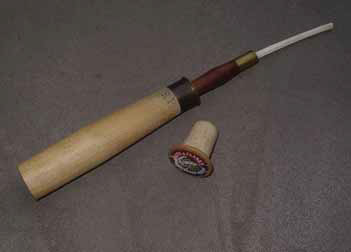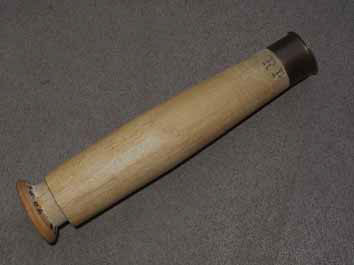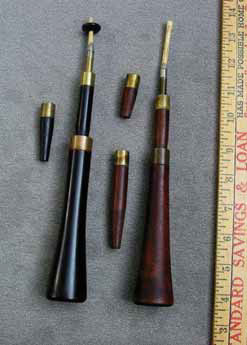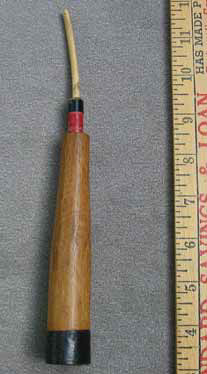By Ralph Permar
When you only use one caller, you will learn to master it like no other.
So it was with Roanoke River Basin Calls, referred to in the future as the caller. Each serious turkey man of modest means made his own call. I asked Parker Whedon if he had found evidence that these old turkey men ever used another type of call made by someone else and available at the time, meaning early 1900s. His answer was “No, not yet.”
He followed up with “I guess it’s like a public speaker or politician who never hears a sweeter sound than that of his own voice.” Parker referred to the present hunting environment as the “new age” hunting we have to put up with.
Guvnor Roan was raised by his uncle, Will Harrell. Will was a friend and hunting compan ion of Simon Everitt. This is well documented in Everitt’s book Tales of Wild Turkey Hunting. Roan made his caller from scratch as did most hunters or had someone else make them. These “home- made” callers were put together from whatever was handy or available as long as it had the right size hole in it or could be modified to make do. It was a trial and error experience. No lip stops— thumb, index and middle fingers were employed for that purpose.
Callers were pitched to the yelping of immature gobblers, birds of the year. There was no spring season. Turkey hunting in the early days was a winter experience. Hen wing bones were the favored mouthpieces (hens were protected in the 30s and 40s, reach your own conclusion).
There were no mating tapers as in the Frank Harpers, as long as the connection between horn and coupling was air tight, that was adequate. Callers were capable of old hen assembly yelps with results. Kee-kees were a product of the users ability, not a high pitch built in the caller.
Jim Stephenson who authored “Big Woods Turkey Call,” also supplied me with Roanoke di- mensions and photos. He and Frank Harper knew each other. They were both from Raleigh, North Carolina. Frank invited Parker to hunt with him “Guvnor” Roan who made his own calls from scratch and was 69 years old at the time. This was the early 1960s. As of 2003, Roan had been dead about 30 years. Using Roan’s caller as a model, Frank enlisted the help of a local wood worker to make “horns,” (bell parts) and couplings as Roan called them, of various woods and dimensions. Horn dimensions were kept constant while cou- pling and mouthpieces were interchanged to get the optimum sounding combination for the indi- vidual using the instrument. Changing couplings and mouthpieces was not for duplicating the sound of an individual turkey that was calling back to a hunter.
The main difference between traditional Roanoke calls and Frank Harper’s design was a three-piece call with flared horn, while traditional calls were two-piece with coupling and mouthpiece being one and the horn being cucumber form in shape.
Caller barrels varied from 4-7/8-inches to 5-1/2-inches. I have made some 6-inch-long but the extra length did not seem to make any differ- ence and was a waste of good wood. Couplings ran from as much as 3-inches or more, to 1-1/2- inches for experimentation. The optimum length usually was 2-1/2-inches. They were bored 3/16, a few 5/32, with a section drilled out to 1/4-inch OD to accept the mouthpiece which commonly was a hen wing bone. Cane was used at times and Frank also had nylon mouthpieces made up after Turpin. (I once doubted the authenticity of a Harper call because of the presence of a nylon mouthpiece, to my embarrassment).
A Brief Note on the Simon Everitt Enigma:
In the latter part of 2002 Mike Battey took up the challenge of finding out exactly what the #50 thread spool was for, as described on pages 28-29 in Everitt’s book. Parker Whedon’s advice to Mike was, “I told Mike that the solution would begin in finding a #50 thread spool.”
Apparently that triggered the thought process because I got a very excited phone call from Mike. He said he came to the conclusion that the spool was used to keep the two parts of the call together, securing the wing bone/coupling assembly inside the horn when the call was not in use. One can see this was an advantage over Roanoke calls where the assembly was kept loose inside the horn.
After Mike described the purpose of the spool to me, I re-read Everitt’s description, went to my lathe, turned a part and sent Mike photos that showed its practical application on one of my own Roanokes. His response was “That’s it!”
One other sticking point was naming Alder as the call’s material in Everitt’s book. However, it was deduced, when he said it grew in a stalk and had soft pith, he was really talking about wood from the Elderberry bush.
It was through Mike’s encouragement that Parker went on to recreate the traditional Simon Everitt call from Elderberry and # 50 thread spool. According to Parker, when he found some “Al- der” he was just going to make a few for fun, but he did go on to produce some for sale. These are real treasures.
Making “New Age “ Roanoke Calls
It all started with the NWTF Nov-Dec 1994 copy of their magazine. It contained Jim Stephenson’s article “Big Woods Turkey Call.” The patina and design of callers pictured fascinated me, but foremost it was an instrument used by “Old Time” turkey men to call birds to the gun. I saved the articles. 1996 brought an article from the magazine on the Jordan yelper and that was the year I started making serious Jordan style turkey calls.
I kept coming back to the Roanokes article but lack of machine and tooling to make them delayed the project until 1998 when I enlisted the help of my cousin, Ron Shealer, to rough out the couplings and barrels since I did not have a wood lathe. I would finish the caller’s interior, mount the fer- rules, turn, tune and install the mouthpieces, all on my new metal lathe. The two courses I took at our local technical school helped.
We entered a Roanoke with an extra coupling assembly at the 1999 NWTF convention in Char- lotte and won first place in the turned barrel trum- pet category. With that success I decided to con- tinue the series of callers out to 100. The series has been sold out except for a few numbers we reserved for ourselves.
I arranged to meet Parker Whedon at the time of my Charlotte trip. It took a while for Parker to warm up to me but talking turkey over cups of his wife’s Russian tea broke the ice and out came the turkey calls. Of special interest to me were the one caller Roan had given Parker and two from Frank Harper.
I took in all the information I could while trying to appear non aggressive in my reconnaissance. After returning home Parker furnished me with photos of the callers. Remember Roan’s callers were completed by hand, while the Harpers were machine finished. Later that year I acquired the equipment to make complete callers on my own but kept my cousin involved with the series of 100.

A Roanoke out of Elderberry with mahogany coupling I did with a #50 thread spool, after the style of Simon Everitt.
In 2000, I went to work completing an interpretation of one of the Harper’s shown in Howard Harlan’s book, plate 3-16, page 38. I then called Parker and asked his thoughts on me marketing these callers as Frank Harper-style Roanokes, in honor of Frank and his work. He thought this was a great idea to honor his friend and was all for it.
In 2006 I made the second interpretive design which I designated Frank Harper “B” style. The “A” style caller has a barrel with a 3/4-inch OD heavy wall brass ferrule and “B” style a 5/8-inch thin wall one with the barrel walls sweeping in a graceful fashion to the bell opening.
“A” style walls are parallel from the ferrule to midway down the barrel where they flare out in funnel fashion straight to the bell’s opening. It is necessary to name and number things to keep track of them. I have an index file full of recorded call making activities over the years and a journal with directions on how to make the styles of calls I produce.
Over the years I have produced many variations of two- and three-piece Harper calls. With turned mouthpieces, they can be counted on to be very consistent in sound from one to another out of the same wood.
In 2002 I designed my one-piece Roanoke Trumpet which gives the sound of young gobblers with a extremely high degree of consistency of sound between callers, utilizing turned delrin mouthpieces. It also did away with the separate parts. My process enabled me to attain a .050″ barrel thickness without cracking the wood. This increased the call’s resonance. A few barrels were so thin you could squeeze them between your fingers and flex the walls. A return to the Clip caller one might say. The Roanoke Trumpet call remains the call I go to today for gobblers that won’t move to any other.
I continue to make all variations of Roanoke River Basin calls today, some with spools, along with my Roanoke Trumpet.
Evolution of Roanoke River Basic Calls:
Cicra1886, one-piece long call attributed to a writer from Mississippi named Clip.
Early 1900s, two-piece Roanoke call and Simon Everitt’s two-piece caller with modification using “spool.”
1960-1965, three-piece Frank Harper style.
1999, new age two-piece made by Ralph Permar and Corry Shealer.
2000, Ralph Permar Frank Harpers “A” and “B.”
2002, Ralph Permar one-piece Roanoke Trumpet.
The List of resources:
“The Voice and Vocabulary of the Wild Tur- key,” Lovett Williams, pages 67-68 Clip Call 1886.
Correspondence between Jim Stephenson of Raleigh, North Carolina and me, 1999-2000.
NWTF magazine, Nov-Dec 1994, “Big Woods Turkey Call.”
Letter from Parker Whedon to Henry Davis, January 21, 1963, cover letter Oct. 29, 2001.
Correspondence and personal visits between Parker Whedon and me.
Letters from Parker to Frank Harper Jr., Feb 27, 1964, March 3, 1964.
Interpretive rendering by Jim Stephenson of original Roanoke River Basin Call, circa 1930.
“Tales of Wild Turkey Hunting,” Simon Everitt, 1928.
“Turkey Calls, An Enduring American Folk Art,” Howard Harlan, 1994.

